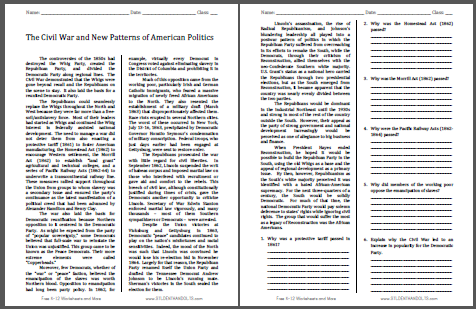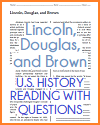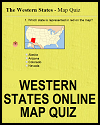| The Civil War and New Patterns of American Politics Reading with Questions |
|---|
| www.studenthandouts.com ↣ American History ↣ American History Readings with Questions |
|
The controversies of the 1850s had destroyed the Whig Party, created the Republican Party, and divided the Democratic Party along regional lines. The Civil War demonstrated that the Whigs were gone beyond recall and the Republicans on the scene to stay. It also laid the basis for a reunited Democratic Party. The Republicans could seamlessly replace the Whigs throughout the North and West because they were far more than a free-soil/antislavery force. Most of their leaders had started as Whigs and continued the Whig interest in federally assisted national development. The need to manage a war did not deter them from also enacting a protective tariff (1861) to foster American manufacturing, the Homestead Act (1862) to encourage Western settlement, the Morrill Act (1862) to establish "land grant" agricultural and technical colleges, and a series of Pacific Railway Acts (1862-64) to underwrite a transcontinental railway line. These measures rallied support throughout the Union from groups to whom slavery was a secondary issue and ensured the party's continuance as the latest manifestation of a political creed that had been advanced by Alexander Hamilton and Henry Clay. The war also laid the basis for Democratic reunification because Northern opposition to it centered in the Democratic Party. As might be expected from the party of "popular sovereignty," some Democrats believed that full-scale war to reinstate the Union was unjustified. This group came to be known as the Peace Democrats. Their more extreme elements were called "Copperheads."  Moreover, few Democrats, whether of the "war" or "peace" faction, believed the emancipation of the slaves was worth Northern blood. Opposition to emancipation had long been party policy. In 1862, for example, virtually every Democrat in Congress voted against eliminating slavery in the District of Columbia and prohibiting it in the territories.
Moreover, few Democrats, whether of the "war" or "peace" faction, believed the emancipation of the slaves was worth Northern blood. Opposition to emancipation had long been party policy. In 1862, for example, virtually every Democrat in Congress voted against eliminating slavery in the District of Columbia and prohibiting it in the territories.Much of this opposition came from the working poor, particularly Irish and German Catholic immigrants, who feared a massive migration of newly freed African Americans to the North. They also resented the establishment of a military draft (March 1863) that disproportionately affected them. Race riots erupted in several Northern cities. The worst of these occurred in New York, July 13-16, 1863, precipitated by Democratic Governor Horatio Seymour's condemnation of military conscription. Federal troops, who just days earlier had been engaged at Gettysburg, were sent to restore order. The Republicans prosecuted the war with little regard for civil liberties. In September 1862, Lincoln suspended the writ of habeas corpus and imposed martial law on those who interfered with recruitment or gave aid and comfort to the rebels. This breech of civil law, although constitutionally justified during times of crisis, gave the Democrats another opportunity to criticize Lincoln. Secretary of War Edwin Stanton enforced martial law vigorously, and many thousands—most of them Southern sympathizers or Democrats—were arrested. Despite the Union victories at Vicksburg and Gettysburg in 1863, Democratic "peace" candidates continued to play on the nation's misfortunes and racial sensitivities. Indeed, the mood of the North was such that Lincoln was convinced he would lose his re-election bid in November 1864. Largely for that reason, the Republican Party renamed itself the Union Party and drafted the Tennessee Democrat Andrew Johnson to be Lincoln's running mate. Sherman's victories in the South sealed the election for them. Lincoln's assassination, the rise of Radical Republicanism, and Johnson's blundering leadership all played into a postwar pattern of politics in which the Republican Party suffered from overreaching in its efforts to remake the South, while the Democrats, through their criticism of Reconstruction, allied themselves with the neo-Confederate Southern white majority. U.S. Grant's status as a national hero carried the Republicans through two presidential elections, but as the South emerged from Reconstruction, it became apparent that the country was nearly evenly divided between the two parties. The Republicans would be dominant in the industrial Northeast until the 1930s and strong in most of the rest of the country outside the South. However, their appeal as the party of strong government and national development increasingly would be perceived as one of allegiance to big business and finance. When President Hayes ended Reconstruction, he hoped it would be possible to build the Republican Party in the South, using the old Whigs as a base and the appeal of regional development as a primary issue. By then, however, Republicanism as the South's white majority perceived it was identified with a hated African-American supremacy. For the next three-quarters of a century, the South would be solidly Democratic. For much of that time, the national Democratic Party would pay solemn deference to states' rights while ignoring civil rights. The group that would suffer the most as a legacy of Reconstruction was the African Americans. Click here to print this worksheet. Answer Key: (1) To foster American manufacturing; (2) To encourage Western settlement; (3) To establish "land grant" agricultural and technical colleges; (4) To underwrite a transcontinental railway line; (5) They feared a massive migration of newly freed African Americans to the North; (6) Answers will vary. |
 |  |  |  |  |  |
| www.studenthandouts.com ↣ American History ↣ American History Readings with Questions |








